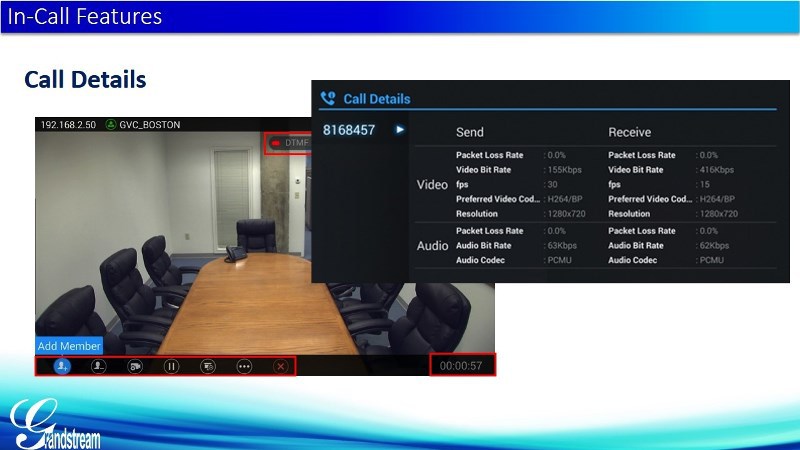Grandstream GVC 3200 Video Conferencing Solution Overview - “It Changes Everything”
Grandstream until recently had two areas: voice IP solutions and solutions for IP video surveillance. Surely you already heard about them: telephones, telephone exchanges, IP-video cameras. Grandstream is now entering the videoconferencing market, and this actually changes a lot for both Grandstream itself and the market.
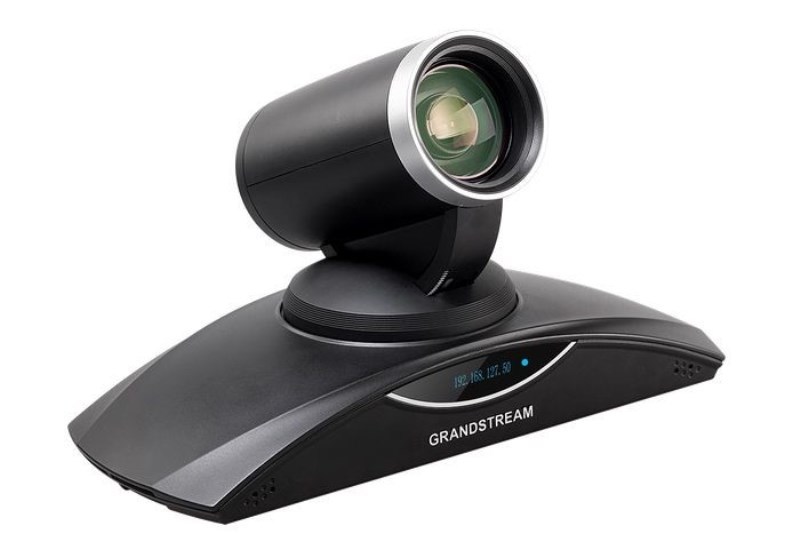
So, Grandstream introduced the GVC3200 - a new Android-based conferencing system that will cost customers much cheaper than competitors like LifeSize, Polycom, Cisco, etc. This platform works on Android 4.4 (it is planned to upgrade to version 5), it is capable of transmitting images in 1080p resolution and supports up to 9 simultaneously connected participants: 4 - Full HD, 5 - HD, 9 - VGA. The device supports connecting up to three video panels via HDMI: 2 - for video conferencing and 1 - for demonstrating content from a PC (VGA or HDMI). The GVC3200 uses a 12x optical zoom PTZ camera and supports the IPVideoTalkPro conference service. Under the cut, a detailed review of the solution and additional services of Grandstream for the videoconferencing.

The slogan “This changes everything” - “It changes everything” is said loudly, but in reality it changes, if not everything, then much, and not only for Grandstream itself. Yes, there were and are video telephones in the line, but these are, nevertheless, video call solutions. Grandstream chose a slightly different approach for the videoconferencing system - the belief in the ability to change the video conferencing market by bringing this solution to its “native” market segment - SMB.

Nowadays, video conferencing is considered to be large, expensive, and complex solutions. Therefore, Grandstream took the path of simplifying such systems in terms of use, i.e. provided an opportunity for an ordinary office user, even without technical skills, to independently deploy and use this solution: they got it out of the box, connected to the TV via HDMI, connected to the Internet, that's all.
This device is controlled by the Android OS and runs on open protocols, so it is very easy to interact and integrate into existing systems. The system supports a fairly large number of functions that modern users need, and which we will talk about.
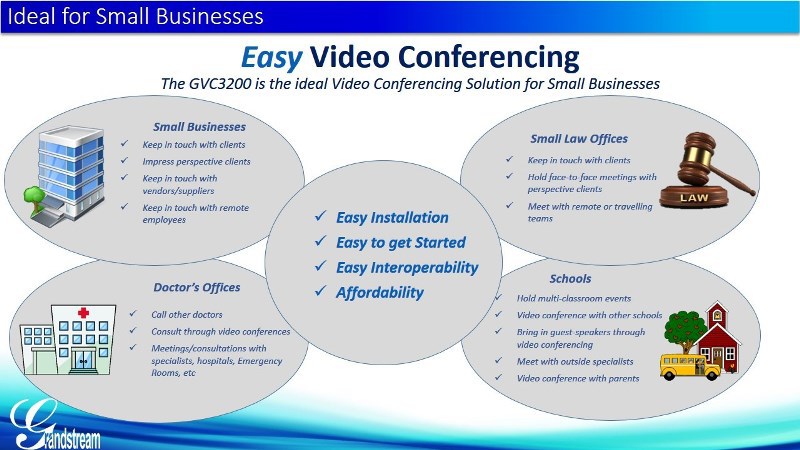
First of all, as already mentioned, Grandstream plans to offer its own VCS option to small companies that have several offices in the country (countries) and which need to be constantly in touch - to hold meetings and meetings, and thus reduce costs for business trips.
Now the topic of distance learning is actively developing. Schools, universities, and other educational institutions that do not have large budgets can afford it for organizing distance learning with the effect of presence, for example.
Grandstream already has projects, unfortunately, not yet in our region (CIS), on telemedicine, when Grandstream solutions are used to organize mobile hospitals, to transmit video for medical purposes.
Typically, in small companies there is no dedicated administrator who configures the entire complex of videoconferencing - there are no resources for this. Such companies need a simple system, which is included - it has earned. Also, quite often you need the ability to integrate with some third-party applications, because SMB has a diverse fleet of equipment. Something has already been bought, it is a pity to throw it away, so they save it, etc. This videoconferencing solution has the ability to integrate into an existing IT infrastructure. However, despite the fact that this model was created for the small and medium business segment, it can be used in large companies.
Grandstream positions its videoconferencing solutions as affordable, even compared to its competitors, the so-called "Chinese brothers." If we compare the “A” brands, then the price difference is significant (from 100% and above). Grandstream wants to reverse this situation when small and medium-sized businesses did not even think about video conferencing due to the high cost of solutions. Now he will be able to afford it.
The GVC3200 supports Full HD resolution and has a built-in video conferencing server (MCU) - that is, it does not require any additional servers or additional devices for organizing video conferencing. With the help of one such module, you can arrange a video conference from 4 participants Full HD, 5 - HD, up to 9 participants - in a standard VGA resolution of 640x480. The module has a Full HD PTZ camera that captures video up to 30 frames per second, with 12x optical zoom - this is a good enough zoom for large meeting rooms. A good set of built-in ports and interfaces: gigabit Ethernet, Wi-Fi, Bluetooth 4.0 for connecting speakers and remote control. You can connect a keyboard, mouse.
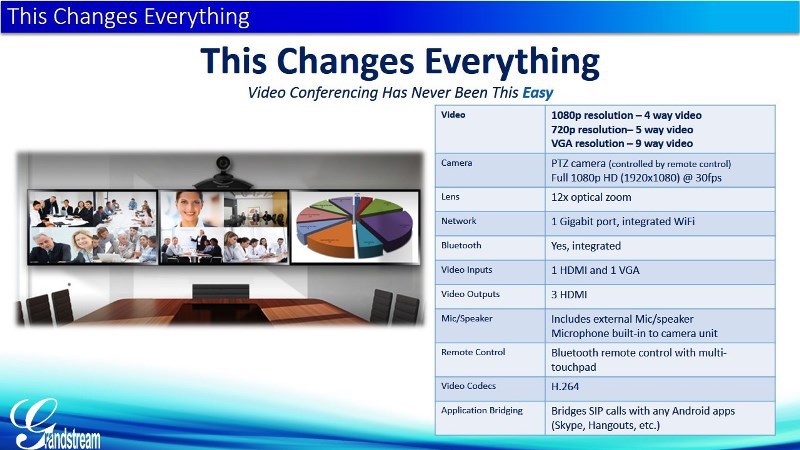
As shown in the slide, it is possible to connect up to three displays to a single terminal to output a different image. You can also connect a computer via VGA or HDMI to demonstrate the presentation in a video conference. For video transmission, the H.264 or H.264 High Profile video codec is used to transmit better voice quality.
The solution comes bundled with IPVideoTalk Pro, a cloud-based video conferencing service. If you have previously encountered Grandstream video telephones (GXV3240 and GXV3275 video telephones) - there is also a similar IPViewTalk service there. Thus, when you turn on the phone on the Internet, you automatically receive a certain number from the Grandstream cloud service without additional settings, and you can already call other same phones by this number.
Grandstream plans to develop a similar service for video conferencing - it will be called IPVideoTalk with the prefix Pro - more on this below.

Installing a videoconferencing module consists of only two steps:
1 connecting to a TV and audio module
2 connecting to the Internet
- that's all, you can use it.
For comparison, an example of a guide to installing a competitor is given - the user himself can not figure it out.
The system is completely ready for use “out of the box”, the kit
includes : • the module itself, which includes a video camera, video terminal, MCU and built-in microphones,
• an external audio module,
• a remote control with batteries
• the necessary set of various cables, including 4 HDMI cables of various lengths for connecting three televisions and a computer, an Ethernet cable
• power supplies, wall mounts, all the necessary screws
• a booklet with instructions, a cover for the camera’s optics and even a napkin.
Thus, in the box you get a complete solution. You don’t have to pay extra for anything - everything comes complete.
A very important point - there are no licenses. Neither video permission nor the number of conference participants is licensed. By paying a fixed amount, you get a solution with a free lifetime software update, with a guarantee that is provided according to the laws of the country (as a rule, this is standard for 1 year).
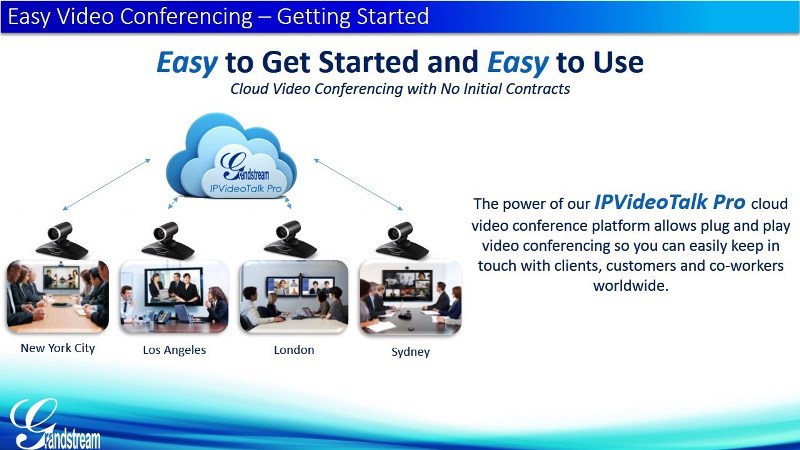
Suppose you have several offices in different cities. In each office you put on the terminal, included in the Internet. The terminal automatically received a unique number from the Grandstream IPVideoTalk Pro cloud service, and you can already call this unique number. Everything is simple.
No need to install additional telephone exchanges, configure routers, etc. This is the basic functionality of this service. In the future, Grandstream plans to expand this service, additional services will probably be by subscription, but this is later, since at the moment it is still in development. But the free room service for simplified calling is already working.
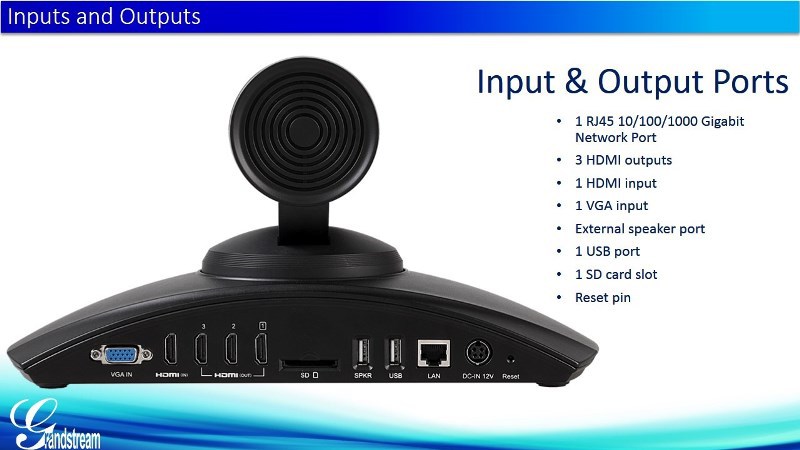
The system consists of one module, that is, it is an all-in-one, 3 HDMI ports for connecting TVs, VGA or HDMI for connecting a computer. SD slot for recording video calls, two USB ports, one for connecting an external audio system, the second for connecting a mouse, keyboard, flash drive (that is, you can connect everything that is supported by Android), one gigabit LAN port, a connector for the unit nutrition. There is also a built-in Wi-Fi n-standard module and two microphones on the front side.

The GVC3200 can be used as a SIP client for an existing system of manufacturers listed on the slide - LifeSize, Cisco, Polycom, etc. Grandstream in its releases reports on testing with various systems, and on request can send the results of these tests.
The solution can work with third-party cloud SIP services, such as BlueJeans. By the way, BlueJeans is a video conferencing system, a cloud service for multipoint conferences. This is a paid service, but its account is already integrated and pre-configured in the GVC module like IpVideoTalkPro, that is, if you want to become a BlueJeans subscriber, you can immediately start using this service.
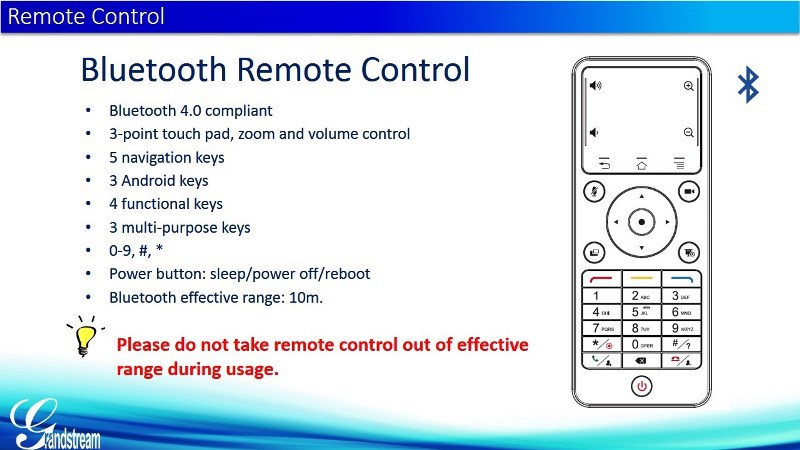
To control this whole thing, a Bluetooth remote control is used. The fact that it is not infrared is convenient enough - you do not need to constantly direct it directly to the terminal. Bluetooth version 4.0 is used, in the upper part there is a touch panel for cursor control. It is powered by AAA batteries. It works at a distance of 10 m.
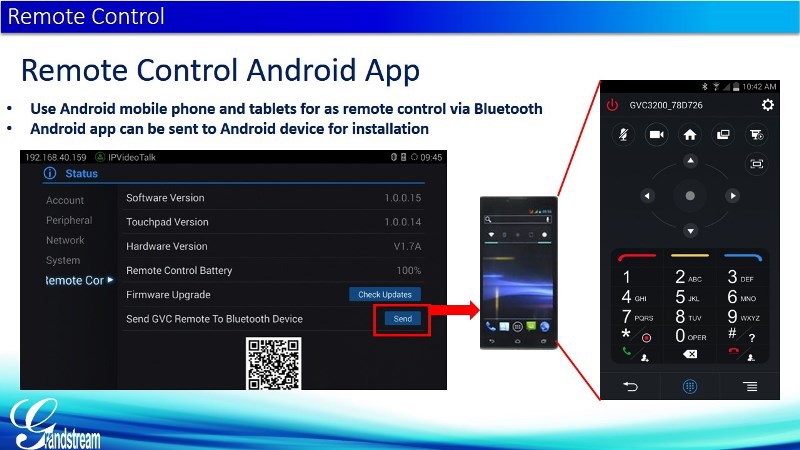
There is also an Android application that allows you to use any Android device, such as your smartphone, as a remote control. You can scan the QR code from the screen, which will lead to the application download page.

There is also the ability to control the GVC through a web interface. You can go to the IP address, open the web interface and all the functions of the remote control are also available there: dialing, rotation, presets, and so on. This may be necessary if the conference is held in a large hall and the system is controlled by a separate operator.

Since the whole system runs on Android and is registered in the Google Play app store, it becomes very easy to install and work with third-party applications. This is of course Skype, and further down the list: Google Hangouts, Microsoft Lync, etc., that is, everything that works on Android smartphones can be tried.
It is also revolutionary that a Skype, Hangouts, and Lync subscriber can join a video conference on a par with other SIP participants. However, today it is possible to attach only one such participant and there is a small nuance: the participant with Skype and the organizer will see and hear all participants in the conference, and remote SIP participants will only be able to hear the participant on Skype.
An SDK is available for customers who write their applications and use them on video conferencing systems. Thus, it is possible to develop your own application for Android.
As already mentioned, the solution works in any SIP network if it supports video calls.

The GVC Grandstream videoconferencing system naturally integrates with its own Grandstream GXV3275 and GXV3240 video telephones, which can be used as clients in video conferencing. Plus, the manufacturer has a GrandstreamWave softphone, which is still available for Android. It is planned that the softphone will support video and will also work on Apple devices.
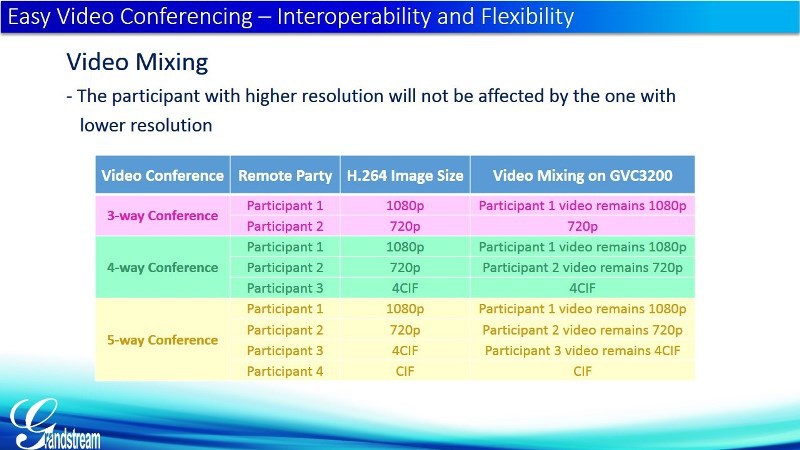
For competitors in the basic solution, if one of the participants connected in low resolution, for example, CIF, then all participants automatically switch to low resolution. To avoid this you need to buy an expensive license. Video mixing in the videoconferencing Grandstream - for free, which also pleases.
If a participant with a lower resolution joins the conference, this will not affect other participants. The system can combine different streams: one window will be in CIF resolution, for example, another window will be in Full HD resolution, and, in any case, with different types of streams from different devices, these streams will not affect each other.
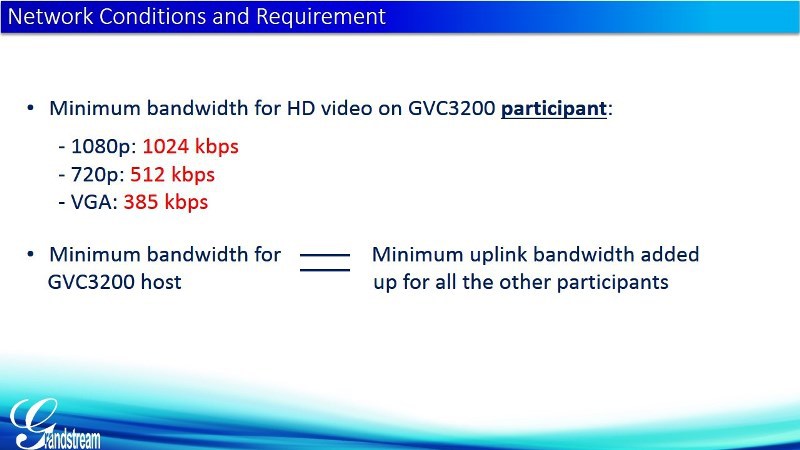
The minimum channel width for each participant with a Full HD stream is 1 megabit. With HD resolution, it’s 500 kilobits per second and VGA 385 kbps with a stream of 30 frames per second. The stream at the video conferencing point is the sum of all streams.

If necessary, if there is a good channel, you can increase the bitrate, and then the same Full HD stream can be increased to 4 megabits, this will be the best picture quality and detail. Convenience in work, image resolution, image detailing - all these things are quite subjective, so customers can easily agree and take the system from the distributor for a test before buying to make sure the conference is working properly in the current conditions.

The system allows you to connect a computer to demonstrate content, for example, to transmit a presentation in Power Point format during a video conference. The speaker is connected via HDMI or VGA, the presentation is turned on / off by pressing a button on the remote control.

The presentation is transmitted in a separate stream via the open standard BFCP protocol for the transmission of presentations. This BFCP protocol must be supported on the server (telephone exchange) and the terminals of the other participants must be able to play in Full HD resolution. A good feature of the GXV3200 is that the presentation is transmitted at up to 15 frames per second. Most competitive systems transmit a presentation at 5 frames per second, so you can only transfer a static image. When transmitting 15 frames per second, it becomes possible to embed a video, for example, a demonstration of the desktop, etc. Most likely, there will still be discontinuity, but the overall image will be smooth - there will be no annoying mouse jumps.
Grandstream telephone exchanges and the IPVideoTalk cloud server support the BFCP protocol. During the demonstration, you can choose various options for how you want your presentation to look: only a presentation, presentation + people, etc.

The main module has built-in microphones, but they are quite simple and work within 2-3 meters. Therefore, the kit comes with a separate OEM audio module from InFocus. This is a desktop speaker that contains four microphones and a speaker. It can be connected to a video conference via usb, or via Bluetooth, if you want less cables.
Via Bluetooth, you can also connect any third-party speaker with additional microphones, if you do not like the speaker that comes with the kit. Also, if the customer already has some kind of terminal on the table, it can be connected via Bluetooth or USB to the Grandstream video conferencing system. This quarter Grandstream plans to launch its GAC 2200 conference phone - see the announcement on the slide below:
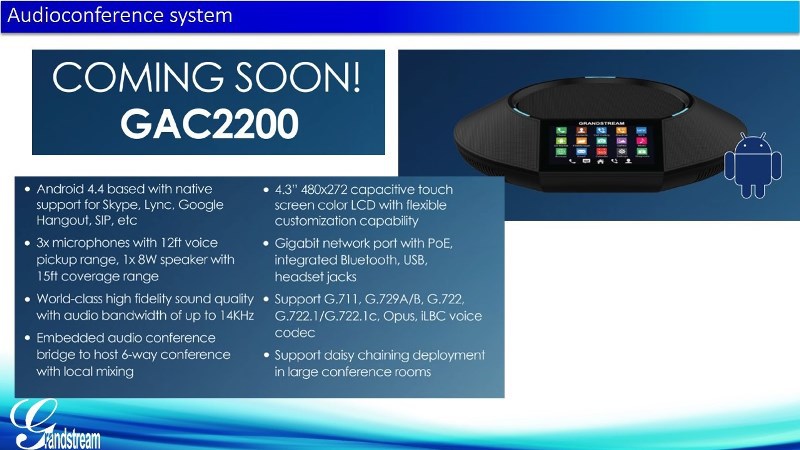
Options for making calls
Functions during a conversation:
Adding participants through third-party applications
Tools
Recording conversations and conferences (without a license!)
Does the camera turn to sound?
Planning
Speed Test Ookla
Выводы

So, Grandstream introduced the GVC3200 - a new Android-based conferencing system that will cost customers much cheaper than competitors like LifeSize, Polycom, Cisco, etc. This platform works on Android 4.4 (it is planned to upgrade to version 5), it is capable of transmitting images in 1080p resolution and supports up to 9 simultaneously connected participants: 4 - Full HD, 5 - HD, 9 - VGA. The device supports connecting up to three video panels via HDMI: 2 - for video conferencing and 1 - for demonstrating content from a PC (VGA or HDMI). The GVC3200 uses a 12x optical zoom PTZ camera and supports the IPVideoTalkPro conference service. Under the cut, a detailed review of the solution and additional services of Grandstream for the videoconferencing.

The slogan “This changes everything” - “It changes everything” is said loudly, but in reality it changes, if not everything, then much, and not only for Grandstream itself. Yes, there were and are video telephones in the line, but these are, nevertheless, video call solutions. Grandstream chose a slightly different approach for the videoconferencing system - the belief in the ability to change the video conferencing market by bringing this solution to its “native” market segment - SMB.

Nowadays, video conferencing is considered to be large, expensive, and complex solutions. Therefore, Grandstream took the path of simplifying such systems in terms of use, i.e. provided an opportunity for an ordinary office user, even without technical skills, to independently deploy and use this solution: they got it out of the box, connected to the TV via HDMI, connected to the Internet, that's all.
This device is controlled by the Android OS and runs on open protocols, so it is very easy to interact and integrate into existing systems. The system supports a fairly large number of functions that modern users need, and which we will talk about.
Where may this decision be relevant?

Small companies
First of all, as already mentioned, Grandstream plans to offer its own VCS option to small companies that have several offices in the country (countries) and which need to be constantly in touch - to hold meetings and meetings, and thus reduce costs for business trips.
Universities
Now the topic of distance learning is actively developing. Schools, universities, and other educational institutions that do not have large budgets can afford it for organizing distance learning with the effect of presence, for example.
Telemedicine
Grandstream already has projects, unfortunately, not yet in our region (CIS), on telemedicine, when Grandstream solutions are used to organize mobile hospitals, to transmit video for medical purposes.
Easy to use and compatible
Typically, in small companies there is no dedicated administrator who configures the entire complex of videoconferencing - there are no resources for this. Such companies need a simple system, which is included - it has earned. Also, quite often you need the ability to integrate with some third-party applications, because SMB has a diverse fleet of equipment. Something has already been bought, it is a pity to throw it away, so they save it, etc. This videoconferencing solution has the ability to integrate into an existing IT infrastructure. However, despite the fact that this model was created for the small and medium business segment, it can be used in large companies.
Affordable
Grandstream positions its videoconferencing solutions as affordable, even compared to its competitors, the so-called "Chinese brothers." If we compare the “A” brands, then the price difference is significant (from 100% and above). Grandstream wants to reverse this situation when small and medium-sized businesses did not even think about video conferencing due to the high cost of solutions. Now he will be able to afford it.
Module description
The GVC3200 supports Full HD resolution and has a built-in video conferencing server (MCU) - that is, it does not require any additional servers or additional devices for organizing video conferencing. With the help of one such module, you can arrange a video conference from 4 participants Full HD, 5 - HD, up to 9 participants - in a standard VGA resolution of 640x480. The module has a Full HD PTZ camera that captures video up to 30 frames per second, with 12x optical zoom - this is a good enough zoom for large meeting rooms. A good set of built-in ports and interfaces: gigabit Ethernet, Wi-Fi, Bluetooth 4.0 for connecting speakers and remote control. You can connect a keyboard, mouse.

As shown in the slide, it is possible to connect up to three displays to a single terminal to output a different image. You can also connect a computer via VGA or HDMI to demonstrate the presentation in a video conference. For video transmission, the H.264 or H.264 High Profile video codec is used to transmit better voice quality.
The solution comes bundled with IPVideoTalk Pro, a cloud-based video conferencing service. If you have previously encountered Grandstream video telephones (GXV3240 and GXV3275 video telephones) - there is also a similar IPViewTalk service there. Thus, when you turn on the phone on the Internet, you automatically receive a certain number from the Grandstream cloud service without additional settings, and you can already call other same phones by this number.
Grandstream plans to develop a similar service for video conferencing - it will be called IPVideoTalk with the prefix Pro - more on this below.

Installing a videoconferencing module consists of only two steps:
1 connecting to a TV and audio module
2 connecting to the Internet
- that's all, you can use it.
For comparison, an example of a guide to installing a competitor is given - the user himself can not figure it out.
What is included?
The system is completely ready for use “out of the box”, the kit
includes : • the module itself, which includes a video camera, video terminal, MCU and built-in microphones,
• an external audio module,
• a remote control with batteries
• the necessary set of various cables, including 4 HDMI cables of various lengths for connecting three televisions and a computer, an Ethernet cable
• power supplies, wall mounts, all the necessary screws
• a booklet with instructions, a cover for the camera’s optics and even a napkin.
Thus, in the box you get a complete solution. You don’t have to pay extra for anything - everything comes complete.
No licenses!
A very important point - there are no licenses. Neither video permission nor the number of conference participants is licensed. By paying a fixed amount, you get a solution with a free lifetime software update, with a guarantee that is provided according to the laws of the country (as a rule, this is standard for 1 year).
Cloud service Grandstream IP Video Talk Pro

Suppose you have several offices in different cities. In each office you put on the terminal, included in the Internet. The terminal automatically received a unique number from the Grandstream IPVideoTalk Pro cloud service, and you can already call this unique number. Everything is simple.
No need to install additional telephone exchanges, configure routers, etc. This is the basic functionality of this service. In the future, Grandstream plans to expand this service, additional services will probably be by subscription, but this is later, since at the moment it is still in development. But the free room service for simplified calling is already working.
Interfaces

The system consists of one module, that is, it is an all-in-one, 3 HDMI ports for connecting TVs, VGA or HDMI for connecting a computer. SD slot for recording video calls, two USB ports, one for connecting an external audio system, the second for connecting a mouse, keyboard, flash drive (that is, you can connect everything that is supported by Android), one gigabit LAN port, a connector for the unit nutrition. There is also a built-in Wi-Fi n-standard module and two microphones on the front side.
Integration with third-party systems

The GVC3200 can be used as a SIP client for an existing system of manufacturers listed on the slide - LifeSize, Cisco, Polycom, etc. Grandstream in its releases reports on testing with various systems, and on request can send the results of these tests.
The solution can work with third-party cloud SIP services, such as BlueJeans. By the way, BlueJeans is a video conferencing system, a cloud service for multipoint conferences. This is a paid service, but its account is already integrated and pre-configured in the GVC module like IpVideoTalkPro, that is, if you want to become a BlueJeans subscriber, you can immediately start using this service.
Remote control

To control this whole thing, a Bluetooth remote control is used. The fact that it is not infrared is convenient enough - you do not need to constantly direct it directly to the terminal. Bluetooth version 4.0 is used, in the upper part there is a touch panel for cursor control. It is powered by AAA batteries. It works at a distance of 10 m.

There is also an Android application that allows you to use any Android device, such as your smartphone, as a remote control. You can scan the QR code from the screen, which will lead to the application download page.

There is also the ability to control the GVC through a web interface. You can go to the IP address, open the web interface and all the functions of the remote control are also available there: dialing, rotation, presets, and so on. This may be necessary if the conference is held in a large hall and the system is controlled by a separate operator.
Google Play Apps

Since the whole system runs on Android and is registered in the Google Play app store, it becomes very easy to install and work with third-party applications. This is of course Skype, and further down the list: Google Hangouts, Microsoft Lync, etc., that is, everything that works on Android smartphones can be tried.
It is also revolutionary that a Skype, Hangouts, and Lync subscriber can join a video conference on a par with other SIP participants. However, today it is possible to attach only one such participant and there is a small nuance: the participant with Skype and the organizer will see and hear all participants in the conference, and remote SIP participants will only be able to hear the participant on Skype.
SDK available
An SDK is available for customers who write their applications and use them on video conferencing systems. Thus, it is possible to develop your own application for Android.
SIP video phones
As already mentioned, the solution works in any SIP network if it supports video calls.

The GVC Grandstream videoconferencing system naturally integrates with its own Grandstream GXV3275 and GXV3240 video telephones, which can be used as clients in video conferencing. Plus, the manufacturer has a GrandstreamWave softphone, which is still available for Android. It is planned that the softphone will support video and will also work on Apple devices.
Video mixing

For competitors in the basic solution, if one of the participants connected in low resolution, for example, CIF, then all participants automatically switch to low resolution. To avoid this you need to buy an expensive license. Video mixing in the videoconferencing Grandstream - for free, which also pleases.
If a participant with a lower resolution joins the conference, this will not affect other participants. The system can combine different streams: one window will be in CIF resolution, for example, another window will be in Full HD resolution, and, in any case, with different types of streams from different devices, these streams will not affect each other.
Network bandwidth requirements

The minimum channel width for each participant with a Full HD stream is 1 megabit. With HD resolution, it’s 500 kilobits per second and VGA 385 kbps with a stream of 30 frames per second. The stream at the video conferencing point is the sum of all streams.

If necessary, if there is a good channel, you can increase the bitrate, and then the same Full HD stream can be increased to 4 megabits, this will be the best picture quality and detail. Convenience in work, image resolution, image detailing - all these things are quite subjective, so customers can easily agree and take the system from the distributor for a test before buying to make sure the conference is working properly in the current conditions.
Presentations

The system allows you to connect a computer to demonstrate content, for example, to transmit a presentation in Power Point format during a video conference. The speaker is connected via HDMI or VGA, the presentation is turned on / off by pressing a button on the remote control.
How presentation presentation works

The presentation is transmitted in a separate stream via the open standard BFCP protocol for the transmission of presentations. This BFCP protocol must be supported on the server (telephone exchange) and the terminals of the other participants must be able to play in Full HD resolution. A good feature of the GXV3200 is that the presentation is transmitted at up to 15 frames per second. Most competitive systems transmit a presentation at 5 frames per second, so you can only transfer a static image. When transmitting 15 frames per second, it becomes possible to embed a video, for example, a demonstration of the desktop, etc. Most likely, there will still be discontinuity, but the overall image will be smooth - there will be no annoying mouse jumps.
Grandstream telephone exchanges and the IPVideoTalk cloud server support the BFCP protocol. During the demonstration, you can choose various options for how you want your presentation to look: only a presentation, presentation + people, etc.
Audio module

The main module has built-in microphones, but they are quite simple and work within 2-3 meters. Therefore, the kit comes with a separate OEM audio module from InFocus. This is a desktop speaker that contains four microphones and a speaker. It can be connected to a video conference via usb, or via Bluetooth, if you want less cables.
Via Bluetooth, you can also connect any third-party speaker with additional microphones, if you do not like the speaker that comes with the kit. Also, if the customer already has some kind of terminal on the table, it can be connected via Bluetooth or USB to the Grandstream video conferencing system. This quarter Grandstream plans to launch its GAC 2200 conference phone - see the announcement on the slide below:



